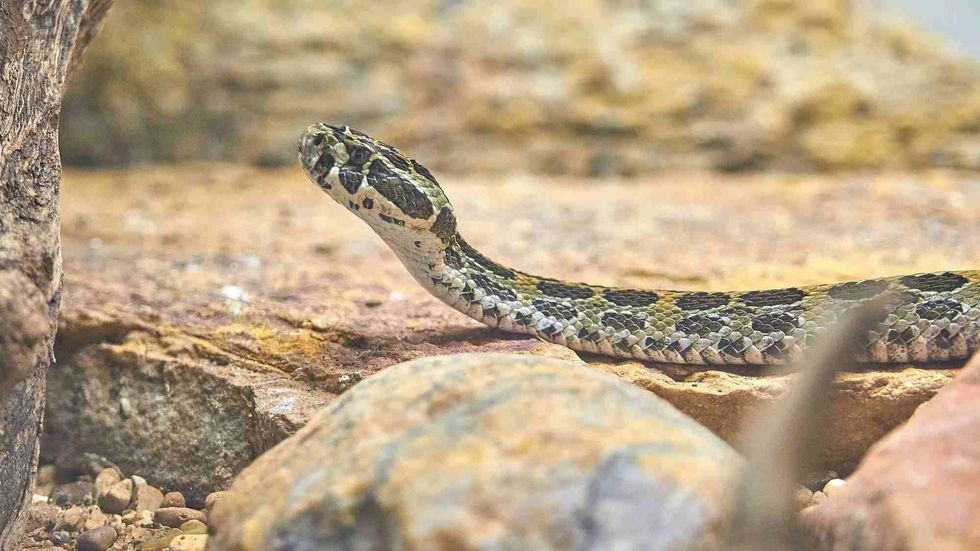Snake physiology and reptile physiology, in general, deviate a little from the typical mammalian body when it comes to the process of excreting the remnants.
In humans, poop usually comes out through an anus, often known as a bum. On the other hand, pee is produced by the urethra, which is found within or near the reproductive organs.
Let's have a look at the digestive system of a snake. Snakes, like humans, feed using their mouths, but they do not chew the food. Therefore, they consume it whole and take a long time to digest it.
Several snakes similarly deform their jaws in trying to swallow larger prey. Food travels into the small intestine after being broken down by stomach acid and various other enzymes. Snakes have an aperture called a cloaca or vent.
This hole is used for reproduction and the removal of excrement and the reptilian version of urine (pee). That's an opening right above the tail at the end of the small intestine tract.
This vent, which resembles a huge scale, is found on the snake's belly. Until it's time to use it, this amazing organ is hidden from view. Snakes also utilize this aperture for laying eggs and mating.
If you loved this article, why not also read about do corn snakes bite or what is a group of snakes called here on Kidadl.
Do snakes poop out bones?
Since they only feed once every few months, snakes poop less regularly than 95% of the population of living beings because snakes may go up to a year not eating. This has a similar impact on their pooping schedule. Yes, you read it right!
Snakes can go a year without wanting to poop. Only after the entire prey item is ready to be disposed of will a snake poop. But what does snake poop look like?
Snake's feces is firm, and snake poop looks like dark brown in healthy snakes. It comes out lumpy and elongated (log-shaped). A snake poo will have a slimy covering if it is well-hydrated.
It's moist when it's new, but it will soon dry out and become a solid mass. Snakes poop smell like any other predatory animal's feces. However, some snake species have stinky excrement than others.
Snakes can also release liquid urine in addition to solid urates, which occur more frequently in pet snakes than in wild snakes. Pet snakes don't need to save liquids because they have a regular supply of water.
Liquid snake pee is comparable to that of any other animal. Its color ranges from clear to pale yellow. When pet snakes are touched, they may emit a musk.
If a snake has a digestive condition, such as an infection, the snake poop smell even more than usual. Does snake poop look like dog poop? Apart from being brown, there are differences as such sometimes snake poop can be white.
The excrement of garter snakes is commonly regarded as the foulest of all serpents. Snake poop consists of two parts, like many other animals, a fecal fragment and uric acid.
Snakes eat their prey entire and consume it whole. Snakes digest bones. Only when a snake's whole food has been digested and is ready to be ejected will it poop.
They usually have one huge deposit as a by-product of each food they ingest, rather than several tiny deposits. The snake's digestive system digests everything, including the animal's bones snakes have powerful stomach acid and a pH of 1.5. A snake's acidity, along with various enzymes, allows it to disintegrate bones in the digestive tract.
On the other hand, snakes can totally digest their prey's skeleton; thus, you won't typically discover bones in their feces. The prey stays in the snake's stomach for days or even weeks, allowing it to be properly digested. Bones are a good supply of calcium, which is necessary for a snake's well-being.
Do snakes poop and pee at the same time?
The poo and pee come from the same location since the sexual organs of male and female snakes are inside. Instead of liquid urine, most snakes expel solid urates.
Snakes poop once after one to four meals and pee somewhat more frequently. Snake urine can sometimes be liquid, but it commonly comes out in solid white lumps known as urates.
Snake droppings resemble dog poop in appearance, being brown, but there are several differences.
Snake urine can also have a white particle that has been digested; this is usually the hair of mice. Because a snake's feces and pee come from the same area (the cloaca), it is typical for a snake to release both liquid urine and poo simultaneously.
Furthermore, the food they consume is wet and contains blood, which is digested and expelled by the snake at the same time. Snake's poop smells just like any other animal's feces. It comprises the snake's last meal's unprocessed components, and the feces are the same width as a snake's body.
Snake pee in liquid form has a mild odor. Urea is a liquid waste produced by a human. Snakes, on the other hand, lack a urine bladder.
As a result, the snake's urine is solid rather than liquid urine like human pee. Snakes excrete uric acid, a semisolid, instead of body fluids to conserve them. Snake pee is very concentrated.
Urates are the lumps of solid urine that you'll observe in your snake's habitat. Snake urates resemble excrement; however, instead of brown, they are white or yellow. Snake poop looks like dark brown.
These brown feces resemble avian poop. Because snakes' bodies hang on to as much water as possible, snake pee takes long to produce. As a result, fecal matter accounts for up to 5-20% of a snake's body weight at any particular time.
Snake urine is usually a solid waste. Generally, snakes pee along with their poo. The disposal of snakes pee occurs from the cloaca.
When do snakes poop after eating?

The size of the snake, the size of the food they've consumed, and lastly, the snake's age all play a role in deciding when they will poop.
To begin with, the size of the snake will dictate its speed according to the amount of stomach acid it has. When a ball python ate a rat of reasonable size, it could take up to a week or longer for the rat to excrete.
Hence ball pythons take a longer time to poop. When a juvenile snake is left alone when it is young, it is genetically predisposed to hunt.
Due to their quick growth rate, a youngster will eat more frequently on smaller meals and poop more often to repeat the process.
A bush viper feces every three to seven days, whereas a rat snake poops in two days. Larger snakes may excrete a lot of liquid pee in their droppings.
Do corn snakes poop a lot?
Snakes prefer huge, irregular meals to tiny, regular ones, and therefore snakes poop infrequently due to this. Heavy-bodied snakes keep feces on their bodies to aid in hunting. Slow-moving land snakes utilize their feces as support to keep their bodies stable.
Corn snakes frequently poop or discharge waste three to five days after being fed. Any other waste passed during these three days is mainly leftover food from the prior meal.
Corn snakes have a fantastic digestive system that produces almost no waste. As an indication of discomfort or displeasure, many corn pet snakes will poop on people. Corn snakes usually poop when they are threatened or insecure, such as when they are placed on the floor.
Do snakes poop in the same spot?
The body of a snake is inherently odorless. When a snake has passed its feces, it will frequently begin looking for its next food as the body prepares for another food cycle.
Because snakes don't care where they poop, droppings can be discovered almost anywhere on a property. They don't usually crawl very high, so cellars, ground floors, and wall cavities are the most common places to find them.
Do snakes poop in their hide?
Snakes can't digest all of their prey, even if snakes swallow it whole. Fibrous and indigestible elements are excreted in the form of feces, which occurs after each meal.
Yes, the snake uses their hide as a toilet, which is why most pet snake owners prefer a non-porous hide that is easy to clean and disinfect. Bathing a snake in warm water encourages it to absorb water and softens the excrement.
The snakes may be trying to help themselves pass the fecal matter if they are relaxing in their water bowl.
The presence of a snake's excrement in a snake tank can encourage the growth of bacteria. Urine and droppings are buried in the substrate within the hide or behind tank ornaments.
Here at Kidadl, we have carefully created lots of interesting family-friendly facts for everyone to enjoy! If you liked our suggestions for do snakes have tails, then why not take a look at do garter snakes eat mice or do hawks eat snakes.










